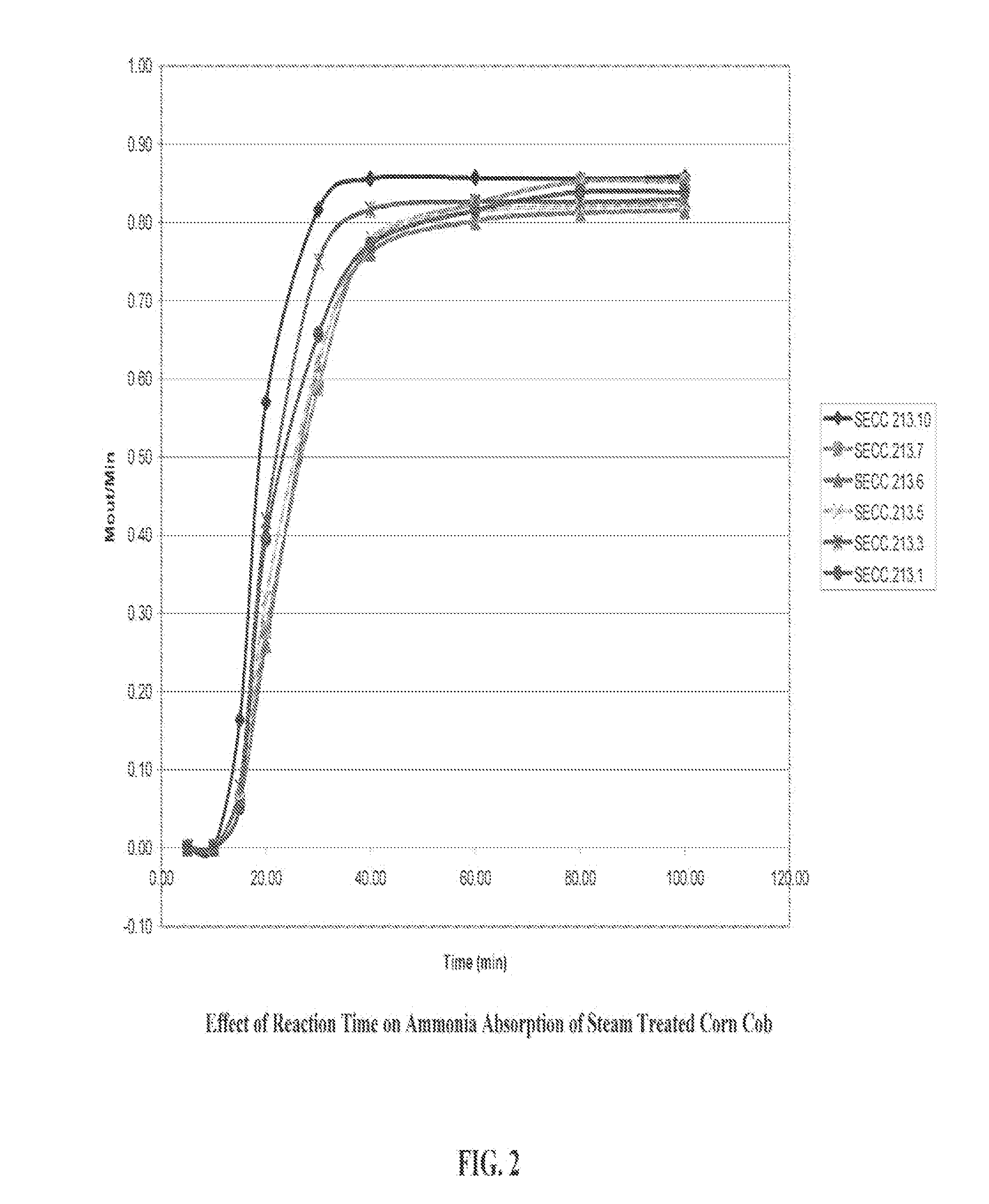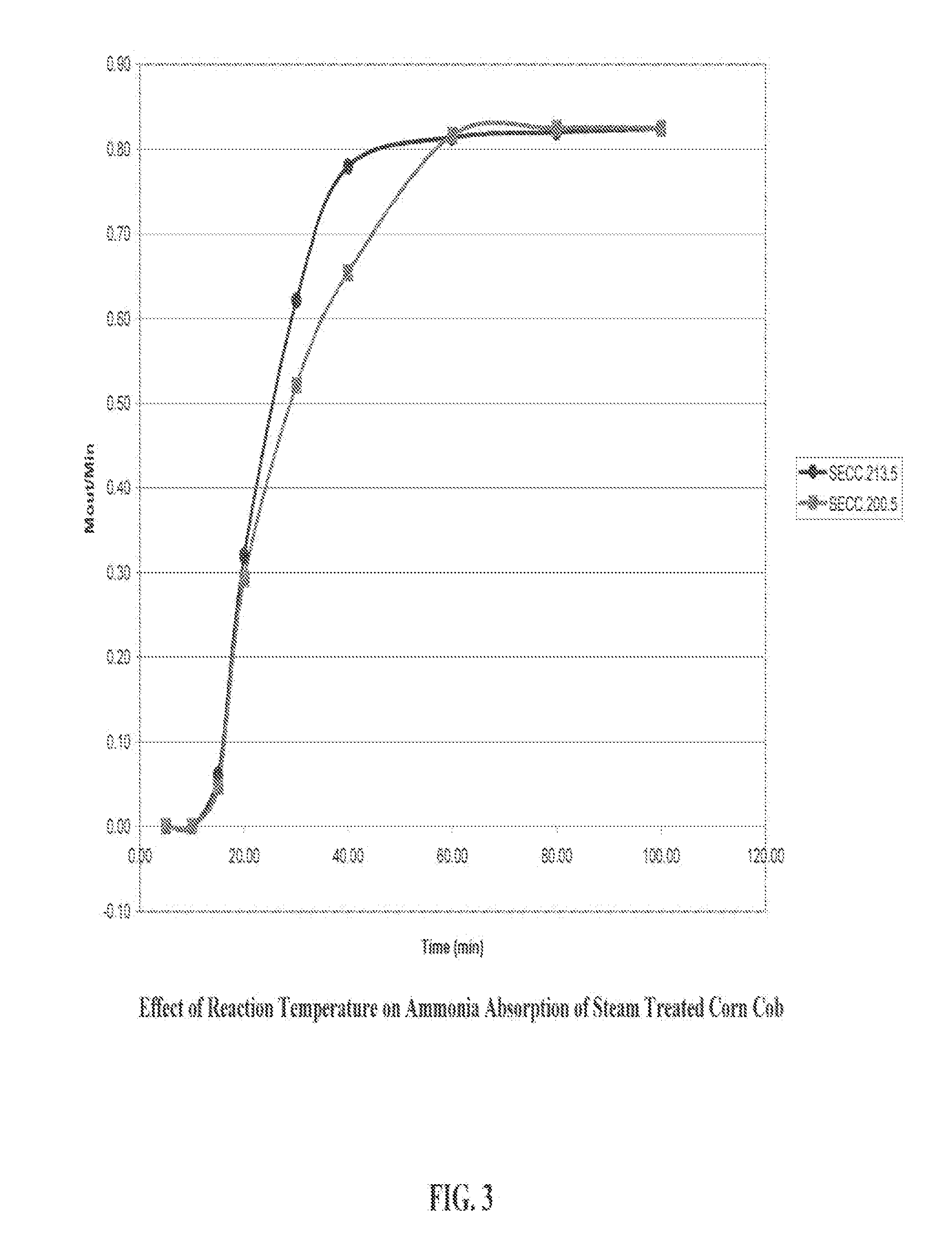Biodegradable litter amendment material from agricultural residues
a technology of agricultural residues and litter amendments, applied in the field of biodegradable materials, can solve the problems of increasing court challenges to air quality regulations, affecting the value of fertilizer, and affecting the production and emission of nh/sub>3/sub>from afos
- Summary
- Abstract
- Description
- Claims
- Application Information
AI Technical Summary
Benefits of technology
Problems solved by technology
Method used
Image
Examples
example i
[0051]About 1 kg of “as received” corn cob (unprocessed, e.g., not milled) was loaded into a 25-L steam explosion gun and steam was admitted into the chamber. The temperature of the corn cob was raised to 210° C. After the reaction proceeded for 60 seconds, the steam pressure was released, resulting in the decompression and mechanical disintegration of the corn cob. The steam exploded corn cob (SECC) was a fine brown powder with low moisture content (40 wt %) and, when slurried with water, had a pH of 3.65.
[0052]In a first instance, a packed-column, reactor consisting of a 61×5 cm glass cylindrical vessel with a fritted glass bottom was used to evaluate the ammonia absorption capacity of the SECC. The reactor was packed with 8-cm thick. SECC material and nitrogen gas containing 150 ppm of ammonia was admitted into the reactor chamber through the fitted glass distributor. The gas was passed through the 8-cm thick SECC layer for 10, 20, and 30 minute periods. The gas exiting the react...
example ii
[0061]About 1 kg of “as received” cotton gin waste was loaded into a 25-L steam explosion gun and steam was admitted into the chamber. The temperature of the cotton gin waste was raised to 210° C. After the reaction proceeded for 60 seconds, the steam pressure was released, resulting in the decompression and mechanical disintegration of the cotton gin waste. The steam exploded cotton gin waste (SECGW) was a fine brown fibrous mixture with low moisture content (40 wt %) and, when slurried with water, had a pH of 6.0. The SECOW removed ammonia when it was packed into the cylindrical glass reactor. It also removed odor and VOC when contacted with broiler litter.
example iii
[0062]About 1 kg hardwood waste chips (one inch particle size) were loaded into a 25-L steam explosion gun. Steam was admitted into the chamber. The temperature of the wood chips was raised to 235° C. After the reaction proceeded for 120 seconds, the steam pressure was released, resulting in the decompression and mechanical disintegration of the wood chips. The steam exploded wood chips (SEWC) was a fine brown powder with low moisture content (40 wt. %) and, when slurried with water, had a pH of 3.5. The steam exploded wood chips also showed strong reaction with ammonia, reduced odor, and VOC.
[0063]The broiler litter and broiler litter amended with SECC were subjected to head space solid phase micro-extraction (HS—SPME) for volatile compounds. In this process, the samples were placed in 20 mL head space vials. The extraction of the head space was conducted with 30 / 50 μm divinylbenzene / carboxene / polydimethylsiloxane SPME fiber and conducted at 60° C. for 30 minutes. The sample was de...
PUM
| Property | Measurement | Unit |
|---|---|---|
| temperature | aaaaa | aaaaa |
| temperatures | aaaaa | aaaaa |
| temperatures | aaaaa | aaaaa |
Abstract
Description
Claims
Application Information
 Login to View More
Login to View More - R&D
- Intellectual Property
- Life Sciences
- Materials
- Tech Scout
- Unparalleled Data Quality
- Higher Quality Content
- 60% Fewer Hallucinations
Browse by: Latest US Patents, China's latest patents, Technical Efficacy Thesaurus, Application Domain, Technology Topic, Popular Technical Reports.
© 2025 PatSnap. All rights reserved.Legal|Privacy policy|Modern Slavery Act Transparency Statement|Sitemap|About US| Contact US: help@patsnap.com



